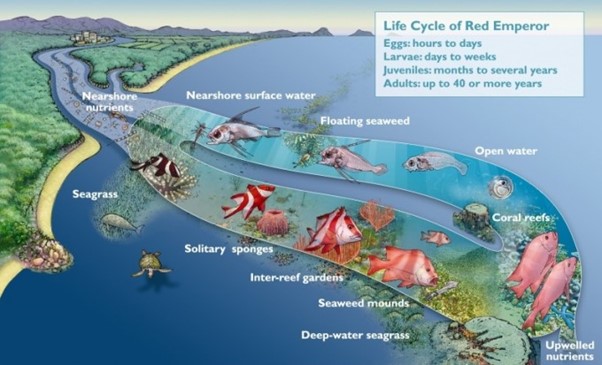They may have the greatest eyesight in all the ocean, but even sharks can’t read maps. And yet, they are reaping the benefits of arguably the most important map on the Great Barrier Reef – the Great Barrier Reef Marine Park Zoning Plan 2003.
Zoning is the foundation on which Reef management is built. It is essentially a simple set of user guidelines which outlines what activities are permitted in different locations across the Reef. However, zoning also serves to protect the Great Barrier Reef’s incredible biodiversity – the variety of plant and animal species, fungi and microbes found across the Marine Park which make the Reef so unique. Each species has an important role to play, and this balance helps to ensure that complex ecosystems like the Reef are better able to cope and recover from significant impacts and stress.
There are 134 species of shark found on the Great Barrier Reef – ranging from small epaulette shark that can walk across reef flats to giant migratory whale shark. Blacktip reef sharks are among the most abundant and can be found from inshore mangrove habitats to coral reefs.
Reef Authority Chief Scientist, Dr Roger Beeden, remembers fondly the sight of a blacktip reef shark pup dancing in the shallows of Orpheus Island.
“It was swimming in and out of the mangrove roots, learning how to hunt and corner little fish,” Dr Beeden says.
Blacktip pups spend their early years in the safety and cover of mangrove roots and are just one of many species, dependent on these forests for their survival. As they grow up, they traverse many ecosystems from sandy flats to their homing coral reefs.
“There are so many different species reliant on a multitude of different ecosystems across the Great Barrier Reef. The Reef is much more than just corals. If we are to protect it fully, we must understand that each bioregion or ecosystem contributes in its own way to the whole tapestry that is the Reef. This key to managing the Reef as a whole.
“Twenty years ago, we (the Reef Authority) embarked on a journey with the greatest Reef science minds of the time to map out exactly how biodiverse the Reef is. From seagrass beds to mangrove forests, drop-offs and the open blue – there are a myriad of habitats and even more incredible critters that call them home.”
For the humble tiger prawn, their entire life’s existence is reliant on seagrass beds as the juveniles settle and grow into adults. With only 14 species of seagrass scattered across the Great Barrier Reef, this often-overlooked flora is not only a vital habitat but a substrate stabiliser, a carbon sink and a vital food source for fan favourites of turtles and dugongs who could not survive without.
Hovering on the edge of the outer reef walls, the cleaner wrasse earns its part in the Reef’s tapestry providing a vital service to not only residents but distant travellers. Open for business with a permanent site amongst the corals, animals of all shapes and sizes come to be cleaned from parasites, open wounds and dead skin and scales.
The red emperor, popular amongst fishermen, lives out its life traversing the blue highway. From breeding adults out on the coral reefs, their spawn makes their way to inshore regions, hiding out in seagrass beds and urchin spines before making their way back out to the coral reefs.

Regardless of who they are or where these amazing animals live, each plays a vital role on the Reef. None of whom pay any attention to lines on maps. So how then does one map with a mosaic of colours and lines serve to maintain biological diversity at all levels of ecosystem, habitat, species, population and genes? How can it allow species to evolve and function undisturbed?
“Through the Great Barrier Reef Zoning Plan 2003, one third of the entire Reef, not just the corals but all of the habitats found in the Region, is protected from the impacts of fishing and other harvesting means.”
“The masterminds behind the Zoning Plan ensured that no habitat was left behind. Every aspect that makes the Reef what it is today, had some level of protection.”
A network of areas was created as sanctuaries, protected from extraction or the impact of human-induced disasters; places where a solid ecological base could be forged from which threatened species or habitats can recover or repair themselves – We know these as Green Zones and Pink Zones.
Over the past 20 years, fish have flourished. Coral trout are growing larger under the safety of no hooks, repopulating those regions that are open to fishing. Emperor and snapper who snack on juvenile crown-of-thorns starfish are aiding the plight against outbreaks of this voracious coral predator. In turn, the coral reef habitats thanks to all the critters that keep them healthy are more resilient in the face of disturbance like disease outbreaks, marine heatwaves and cyclones, that they can bounce back faster.
“The frequency of disasters like marine heatwaves and floods and potentially more severe cyclones are increasing in the face of climate change, and the window for the Reef’s ecosystems to recover is narrowing.” says Dr Beeden.
The Outlook Report 2024 has shown us that the impacts of Climate Change remain the main concern for the Reef and are only compounding the cumulative effects of other chronic impacts like unsustainable fishing, pollution and sedimentation.
It is the wealth of habitats, species and genetic riches that underlie the Reef’s resilience, but it is the effective protection and management through tools like the Zoning Plan that its natural beauty and natural phenomena endure. But it is up to all of us, and the window is now to ensure its future.
